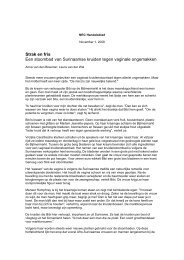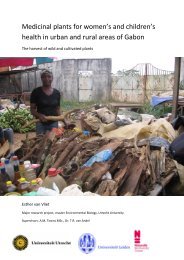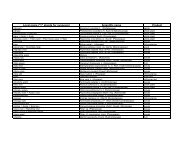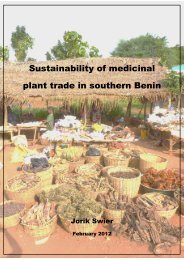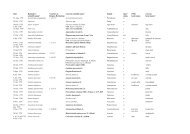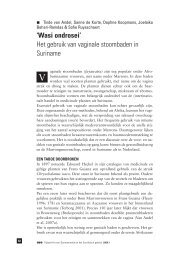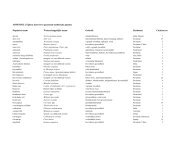T. Heilbron 2012.Botanical relics of the plantations - osodresie
T. Heilbron 2012.Botanical relics of the plantations - osodresie
T. Heilbron 2012.Botanical relics of the plantations - osodresie
Create successful ePaper yourself
Turn your PDF publications into a flip-book with our unique Google optimized e-Paper software.
2 Methodology<br />
The direct motive for this study was <strong>the</strong> request <strong>of</strong> a Dutch tourist operator who recently started a<br />
project for eco-tourism development on part <strong>of</strong> a plantation (Reijnsdorp, Commewijne district).<br />
He encountered rows <strong>of</strong> cacti and a date palm species in <strong>the</strong> forest and was interested in <strong>the</strong><br />
origin and history <strong>of</strong> those plants.<br />
From literature on plantation crops (e.g Van Andel et al., 2012; Rolander, 2008; Ostendorf,<br />
1962; Stahel, 1944), a list was made <strong>of</strong> plant species that might be expected as <strong>relics</strong> on former<br />
<strong>plantations</strong>. The list included most prominent former cash crops, such as Theobroma cacao and<br />
C<strong>of</strong>fea liberica and plants that supported <strong>the</strong>m, for example Erythrina spp. as a shade tree. Some<br />
species described in historical literature as being planted in slave or slave owners’ gardens, such<br />
as Cleome gynandra and Croton tiglium (Rolander, 2008), Furcraea foetida, and plants which,<br />
according to local inhabitants, might have some historical connection to <strong>the</strong> <strong>plantations</strong>, such<br />
as <strong>the</strong> columnar cactus Cereus spp., were also included. Color images <strong>of</strong> <strong>the</strong>se species were<br />
provided to local inhabitants to ask whe<strong>the</strong>r <strong>the</strong>y knew <strong>the</strong>se species and <strong>the</strong>ir locality.<br />
Fieldwork was performed between March 6 th and May 19 th , 2012. After spending 13<br />
days at plantation Reijnsdorp, new locations were chosen according to information gained from<br />
open-ended interviews with local guides, hunters, fishermen and elderly people. Information<br />
regarding <strong>the</strong> whereabouts <strong>of</strong> possible relic individuals was also obtained, and vernacular names<br />
and stories <strong>of</strong> <strong>the</strong> origin <strong>of</strong> <strong>the</strong>se plants were documented. Figure 3 shows <strong>the</strong> location <strong>of</strong> <strong>the</strong><br />
<strong>plantations</strong> where fieldwork was conducted. Generally, <strong>the</strong> <strong>plantations</strong> are distributed over five<br />
areas, namely Warappa creek (#1-12), <strong>the</strong> mouth <strong>of</strong> Commewijne river (#13-18), Orleane creek<br />
(#19-21), <strong>the</strong> mouth <strong>of</strong> <strong>the</strong> Suriname river (#22-25) and <strong>the</strong> lower Suriname river (#26-27) area.<br />
For each <strong>of</strong> <strong>the</strong> <strong>relics</strong>, a botanical voucher was made using standard botanical techniques. The<br />
plants’ locations were logged in a GPS device. Observations on growth form, reproduction,<br />
abundance and specific patterns on site were made, and pictures were taken <strong>of</strong> <strong>the</strong> locality. For<br />
species encountered various times at different localities, only GPS data were collected. For<br />
cacti collected, <strong>the</strong> alcohol method described by De Groot (2011) was used prior to drying.<br />
Duplicates <strong>of</strong> all collected species were deposited at <strong>the</strong> National Herbarium Suriname (BBS)<br />
and <strong>the</strong> National Herbarium <strong>of</strong> <strong>the</strong> Ne<strong>the</strong>rlands (NHN). Collection and export permits were<br />
obtained from <strong>the</strong> Nature Conservation Division <strong>of</strong> <strong>the</strong> Suriname Forest Service (L.B.B.). For<br />
<strong>the</strong> cacti specimens collected, a separate CITES permit was obtained (permit nr. 12189).<br />
After <strong>the</strong> fieldwork, <strong>the</strong> collected specimens were identified using <strong>the</strong> Flora <strong>of</strong> Suriname,<br />
<strong>the</strong> Flora <strong>of</strong> <strong>the</strong> Guianas and <strong>the</strong> Checklist <strong>of</strong> <strong>the</strong> Plants <strong>of</strong> <strong>the</strong> Guianas (Boggan et al., 1997). For<br />
some specimens, specialist botanists were consulted to identify <strong>the</strong> plants to a (sub)species level,<br />
namely P. Maas (NHN) and M. Hakkinen (H) for Musaceae, D. HilleRisLambers for an Oryza<br />
cultivar and M. Nee (NYBG) for Solanaceae. After identification, <strong>the</strong> plants were added to <strong>the</strong><br />
NHN collection. A sample <strong>of</strong> seeds <strong>of</strong> a black Oryza cultivar was sent to <strong>the</strong> Anne van Dijk<br />
Rijst Onderzoekscentrum Nickerie (ADRON) in Suriname for documenting and maintaining<br />
this cultivar. It is currently being grown in Nickerie for comparative research.<br />
Maps were made using ArcGIS 10.0, GPS locations collected during fieldwork, <strong>the</strong> digitized<br />
map <strong>of</strong> Bakhuis et al. (1930), and exported satellite imagery from Google Earth (http:<br />
//earth.google.com). For Phoenix reclinata a distribution map was made with <strong>the</strong> ear-<br />
7



